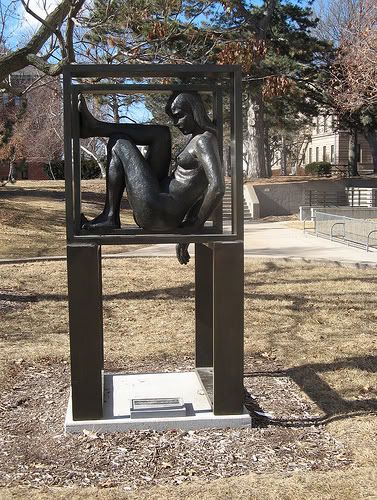 Truthfully, I was dismayed at first to be stuck with Richard Miller's "SANDY: in Defined Space," but after staring at it for the better part of an hour and a half, most anyone can develop some interest in a piece. In short, the sculpture is of a, most likely, younger twenties woman sitting naked inside one of several square shapes balancing on each other so that they in turn form a square shape when viewed from above. Though the bronze sculpture is not entirely intricate, nor does it seem to have been very difficult to construct for a skilled caster, but it does seem to have somewhat deeper meaning than simply an unclothed woman sitting in a box.
Truthfully, I was dismayed at first to be stuck with Richard Miller's "SANDY: in Defined Space," but after staring at it for the better part of an hour and a half, most anyone can develop some interest in a piece. In short, the sculpture is of a, most likely, younger twenties woman sitting naked inside one of several square shapes balancing on each other so that they in turn form a square shape when viewed from above. Though the bronze sculpture is not entirely intricate, nor does it seem to have been very difficult to construct for a skilled caster, but it does seem to have somewhat deeper meaning than simply an unclothed woman sitting in a box.One thing that quickly jumped out to me is the emotion displayed by this sculpture. As we can presume, Sandy is sitting in a crunched up, seemingly uncomfortable position with her head bent over. While the vector of attention from her eyes doesn't lead to anything significant, it does set the mood of the piece. I became sorry for Sandy and even thought the piece would be more aptly named "SANDY: in Confined Space."
There are also a few points that make this piece very difficult to grasp completely. For one, whether Sandy is confined or defined, either of which only make sense to an extent. She does seem well within the boundaries of the box, but notice the one hand that is let loose. Again, from the side, her body sticks out well to each side giving her a certain bit of freedom. Beyond her physical location, but speaking of freedom, she is nude on top of it all. Nakedness is one of the most classic forms of freedom and self exploration possible, yet Sandy is still in a "defined" space. Lastly, through a little bit of research, I found that five castings of this sculpture were made in the 1960s. The two most notable are on the UNL campus and the other resides at the University of Houston. Now if Sandy is confined to only one place, how did she get halfway across the country?
Sandy is an interesting piece, but hardly seems representational of her namesake. through vectors of attention, symbolism and the simple name analysis, we can find that Sandy's being is a bit off. Possibly Robbert Miller had a very narrow mindset for how the sculpture was to be perceived and didn't think of all the ways that it would not make sense, or maybe that's half the reason for the name is to make people wonder why it would take on a name that is so unfitting. Certainly, there is more to be figured out as I delve deeper into the ideas and purpose of "SANDY: in Defined Space."
No comments:
Post a Comment